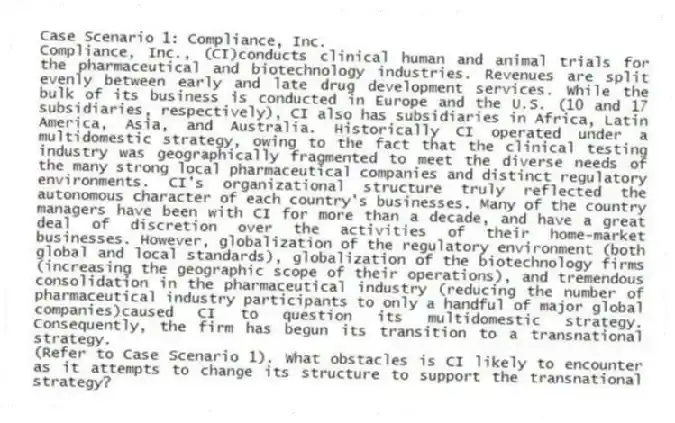
Case Scenario 1: Compliance, Inc.
Compliance, Inc., (CI)conducts clinical human and animal trials for the pharmaceutical and biotechnology industries. Revenues are split evenly between early and late drug development services. While the bulk of its business is conducted in Europe and the U.S. (10 and 17 subsidiaries, respectively), CI also has subsidiaries in Africa, Latin America, Asia, and Australia. Historically CI operated under a multidomestic strategy, owing to the fact that the clinical testing industry was geographically fragmented to meet the diverse needs of the many strong local pharmaceutical companies and distinct regulatory environments. CI's organizational structure truly reflected the autonomous character of each country's businesses. Many of the country managers have been with CI for more than a decade, and have a great deal of discretion over the activities of their home-market businesses. However, globalization of the regulatory environment (both global and local standards), globalization of the biotechnology firms (increasing the geographic scope of their operations), and tremendous consolidation in the pharmaceutical industry (reducing the number of pharmaceutical industry participants to only a handful of major global companies)caused CI to question its multidomestic strategy. Consequently, the firm has begun its transition to a transnational strategy.
-(Refer to Case Scenario 1). What obstacles is CI likely to encounter as it attempts to change its structure to support the transnational strategy?
Correct Answer:
Verified
View Answer
Unlock this answer now
Get Access to more Verified Answers free of charge
Q142: Case Scenario 2: Palmetto.
Palmetto was an early
Q143: Case Scenario 3: Jewell Company.
Jewell Company (JC)is
Q144: Case Scenario 1: Compliance, Inc.
Compliance, Inc., (CI)conducts
Q145: Case Scenario 3: Jewell Company.
Jewell Company (JC)is
Q146: Case Scenario 2: Palmetto.
Palmetto was an early
Q147: Case Scenario 1: Compliance, Inc.
Compliance, Inc., (CI)conducts
Q148: Case Scenario 1: Compliance, Inc.
Compliance, Inc., (CI)conducts
Q149: Case Scenario 2: Palmetto.
Palmetto was an early
Q151: Case Scenario 2: Palmetto.
Palmetto was an early
Q152: Case Scenario 2: Palmetto.
Palmetto was an early
Unlock this Answer For Free Now!
View this answer and more for free by performing one of the following actions

Scan the QR code to install the App and get 2 free unlocks

Unlock quizzes for free by uploading documents